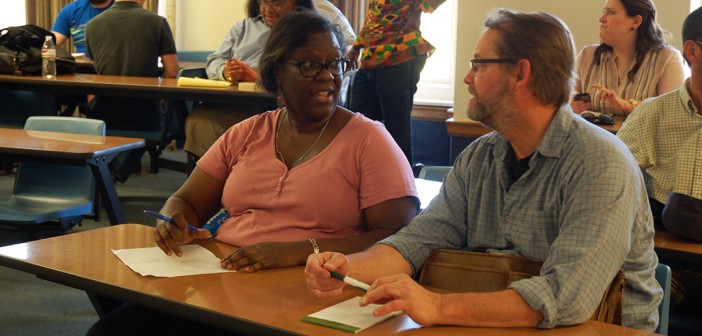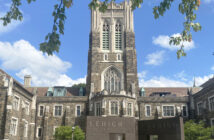The Moravians, a protestant European sect, founded Bethlehem in 1741 as a utopian religious community.
At the time, Bethlehem was considered one the most egalitarian communities in European North America, said Seth Moglen, a professor of English at Lehigh. It created a communal economy where everyone worked for the community, and they equally received food, shelter, clothing, access to free education, childcare, healthcare and care for the elderly.
Bethlehem was a multiracial town in which Africans, Native Americans and Europeans from 20 countries thrived together. It had 100 percent literacy in the 1750s, both male and female, across all racial groups.
However, there was a deep contradiction about this community.
“The egalitarianism of this community was compromised and undermined in emblematically American ways from the very outset,” Moglen said. “This was a slaveholding society.”
In the first 20 years of Bethlehem’s founding, the Moravian Church purchased three dozen enslaved people.
Scott Gordon, the Lehigh department chair for English, said most people are aware African-Americans were in Bethlehem, but many people are unaware that there were slaves here.
“We are extremely proud of our history and all of the many things our early Moravians did and accomplished,” said Diane Shaw, the Moravian Archives treasurer. “The story of slavery, however, is incredibly complex.”
Although the enslaved Africans in Bethlehem were viewed as personal property, Gordon said it is difficult to articulate how their daily life differed from free citizens. Most of the slaves joined the Moravian Church and became full members of the community.
Moglen said the powerful leave detailed records of their past, but the weak leave little record of their experiences.
Gordon said Moravian Bethlehem kept detailed records about everything, which brings a sense of the operations and life in the community.
Moglen talked last Wednesday about the Moravian Archive’s memoirs of enslaved people in Moravian Bethlehem, which he is studying closely for his upcoming book.
Because of the distinctive qualities of Moravian Bethlehem’s literacy across gender, class and race, the Moravian archive has left a “body of memoirs where slaves of the Middle Passage speak,” Moglen said.
In Moravian Bethlehem, it was the responsibility of all community members to write a formulaic memoir before they approached salvation.
“These narratives show the power that commands the slave to speak and structure the story they tell,” Moglen said.
Unlike most narratives such as “Narrative of the Life of Frederick Douglass” by Frederick Douglass, or “Incidents in the Life of a Slave Girl” by Harriet Ann Jacobs, these slave narratives did not focus on denouncing the institution of slavery, but they retraced their faith and entry into a relatively safe community.
Moglen said these memoirs remain mostly unknown to most historians, even specialists in slave history.
Because these memoirs are formulaic and part of a spiritual performance, there are many details not in the documents. For example, Moglen read a memoir of an enslaved African woman, Magdalena — formerly Beulah — who was purchased in 1752 in Philadelphia, that is only three paragraphs long. In her memoir, she said she tried to be sent away from the community, became content and happy, never thought she would be freed from her chains — she eventually was freed — and received forgiveness. There is nothing about her life before crossing the Middle Passage.
Moglen said Magdalena is the first African writing to be discovered in North America.
The brevity of her memoir requires Moglen to read between lines of her story to embody her narrative through literary analysis but to also acknowledge what we cannot know.
Moglen was able to fill in some gaps in Magdalena’s narrative through close readings of her enslaved husband Andrew’s — formerly Ofodobeno Wooma — memoir. In his memoir, Moglen said Andrew sought to explain the trauma in Africa and his terror of religious conversion.
In his memoir, Andrew described his enslavement. He talked about becoming a commodity as a young boy and being torn away from his culture, as well as his account of going over the Middle Passage and his belief that God only loved those who were important and had power.
Moglen said difference in amount of details between memoirs allows us to start understanding this world.
Interestingly, Andrew waited for over a decade to marry Magdalena, but the specific reason is omitted in his memoir. Moglen, however, said this was likely because the condition of the slave is passed from the mother to the child, so Andrew and Magdalena were worried about slavery and their children.
Gordon said Moglen’s interpretive style on these memoirs unpacks the language and is pioneering a way to understand the complex lives of enslaved people in Bethlehem.
Shaw said scholars like Moglen, who bring marginalized people to life, enrich our humanity.
“As we read their narratives, we can hear their voices,” Moglen said. “However, they are short autobiographies that do not reveal everything.”






Comment policy
Comments posted to The Brown and White website are reviewed by a moderator before being approved. Incendiary speech or harassing language, including comments targeted at individuals, may be deemed unacceptable and not published. Spam and other soliciting will also be declined.
The Brown and White also reserves the right to not publish entirely anonymous comments.